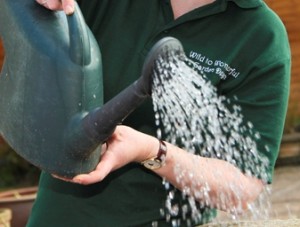The UK is now suffering from a severe drought, due to the shortage of winter rainfall this year and many regions will have hosepipe bans enforced on them, if they haven’t already.
But if you live in a low-rainfall area, it need not stop you gardening! Follow these hints and tips to use your water as wisely as possible:
Careful watering
Timing
Watering in the evening or early in the morning means that more water is absorbed and less is lost by evaporation. You also avoid the risk of scorching the leaves in hot sunshine.
If showers are forecast (and they will come eventually!), do not water your garden at all.
Delivery
Also, by delivering the water directly to the base of the plants means that the plants benefit as much as possible from every drop. Using a drip-watering irrigation system is a good way to do this, and in most areas these are allowed during the hosepipe ban (check your local water authority website for their own rulings). These systems are also equipped with timers, so allowing you to set the watering to the best time of day (see above!)
Retaining moisture
Planting
If planting new trees & shrubs, soak them well before planting, then plant in well-prepared soil with well-rotted compost to retain the moisture in the soil. Water well (a couple of watering cans if necessary) and then cover soil with a layer of mulch.
Plant those plants that are more suited to a dry climate, such as native plants, herbs or plants with Mediterranean origins, so that they do not need as much water once they have established themselves. For a list of drought tolerant plants, visit the RHS website at : http://www.rhs.org.uk/Gardening/Sustainable-gardening/Gardening-in-a-changing-climate/Advice/Dealing-with-Drought
Think carefully before planting up pots and hanging baskets – there is nothing sadder than dried out baskets! If you do decide you are going to be able to keep watering them, mix water-storing granules into the potting compost and position them in shady, sheltered spots, to prevent them from becoming too dried out by sun or wind. Picking larger pots with more compost for the roots will also retain moisture around the plant roots.
Maintenance
Keep your borders well weeded, so that your plants do not have to compete for the limited moisture.
Do not overwork your soil – digging dry soil unnecessarily will lose valuable moisture and you will end up with a dry dusty area.
Keep your lawn grass longer so that it shades itself and sends down deeper roots (and you can save on petrol for your mower!). Don’t feel you have to water your lawns if they go brown – if they are established well, they will green up again at the next rains.
Collecting water
Reuse grey water from your bath or kitchen sink to water your plants (avoid doing this with edible crops however)
Install water butts to collect rainwater from all your roofs, including your shed, greenhouse, garage, as well as your house. If you have a sloping garden, watch to see where water goes when it does rain and install an underground water system.
